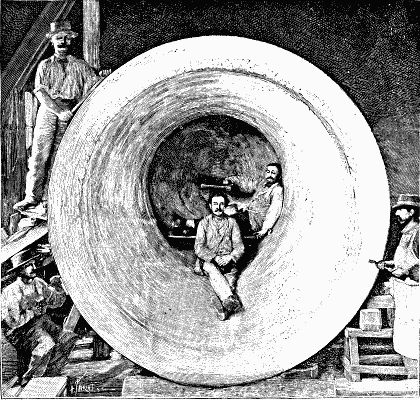The Great Bell Of The Basilica Of The Sacred Heart Of Montmartre
Description
This section is from "Scientific American Supplement". Also available from Amazon: Scientific American Reference Book.
The Great Bell Of The Basilica Of The Sacred Heart Of Montmartre
The main work on the basilica of the Sacred Heart is now completed and the bell tower surmounts it. So we have now a few words to say about "La Savoyarde" - the name of the great bell which is designed for it, and which has just been cast at Annecy-le-Vieux, in Upper Savoy, in the presence of Mgr. Leuilleux, Archbishop of Chambery, Mgr. Isoar, Bishop of Annecy, and of all the clergy united, at the foundry of Messrs. G. & F. Paccard, especially decorated for the occasion.

INTERIOR OF THE BELL.
One of the Latin inscriptions that ornament the metal of "La Savoyarde" at once explains to us its name and tells us why a bell designed for the capital was cast at Annecy-le-Vieux. The following is a translation of it:
"In the year 1888, in the course of the solemnities of the sacerdotal jubilee of the Sovereign Pontifex Leo XIII., I, Frances Margaret of the Sacred Heart of Jesus, on the initiative of Francis Albert Leuilleux, Archbishop of Chambery, with the co-operation of the bishops of the province, at the common expense of the clergy and upper and lower classes of Savoy, was offered as a gift, as a testimonial of piety toward the divine heart, in order to repeat through the ages, from the top of the holy hill, to the city, to the nation and to the entire world, 'Hail Jesus!'"
Let us now witness the casting of the bell.
Over there, at the back of the foundry, in the reverberatory furnace, the alloy of copper and tin, in the proportions of 78 and 22 per cent., is in fusion. From the huge crucible runs a conduit to the pit, at the side of which the furnace is constructed, and in which is placed the mould. A metallic plug intercepts communication. A quick blow with an iron rod removes this plug and the tapping is effected. This operation, which seems simple at first sight, is extremely delicate in practice and requires a very skillful workman. A host of technical words designates the dangers that it presents. Before the tapping, it is necessary to calculate at a glance the function of the gate pit. And what accidents afterward! But we need not dwell upon these. After the cooling of the metal comes the cleaning, which is done with scrapers and special instruments.
The casting is preceded by two operations - the designing and the moulding. The design rests upon a basis generally furnished by experience, and which the founders have transmitted from generation to generation. The thickness of the rim of the bell taken as unity determines the diameters and dimensions. The outline most usually followed gives 15 rims to the large diameter, 7½ to the upper part of the bell, and 32 to the large radius that serves to trace the profiles of the external sides.

THE CASTING OF THE GREAT BELL OF THE BASILICA OF THE SACRED HEART.
The moulding is done as follows: In the pit where the casting is to be done there is constructed a core of bricks and a clay shell, separated from each other by a thickness of earth, called false bell. This occupies provisionally the place of the metal, and will be destroyed at the moment of the casting.
Now let us give a brief description of "La Savoyarde." Its total weight is 25,000 kilogrammes, divided as follows: 16,500 kilogrammes of bronze, 800 kilogrammes for the clapper, and the rest for the suspension gear.
Its height is 3.06 meters and its width at the base is 3.03. It is therefore as high as it is wide, and, as may be seen from our engraving, two men can easily seat themselves in its interior. In weight, it exceeds the bell of Notre Dame, of Paris, which weighs 17,170 kilogrammes, that of the Cathedral of Sens, which weighs 16,230, and that of the Amiens bell, which weighs 11,000. But it cannot be compared to the famous bell given by Eudes Rigauit, Archbishop of Rouen, to the cathedral of that city, and which was so big and heavy that it was necessary to give a copious supply of stimulants to those who rang it, in order "to encourage" them.
"La Savoyarde" will appear small also if we compare it with some celebrated bells, that of the Kremlin of Moscow, for example, which weighs 201,216 kilogrammes. One detail in conclusion: "La Savoyarde" sounds in counter C. This had been desired and foreseen. The number of vibrations, that is to say, the timbre of a bell, is in inverse ratio of its diameter or of the cubic root of its weight, so that in calculating the diameters and in designing "La Savoyarde" the timbre was calculated at the same time. - L'Illustration.
[FROM THE SUGAR BEET.]
Continue to:


